Launch Everywhere—How Uber Won 450+ Markets
Update 1 August 2016
In a surprising turn of events, several sources are reporting that Uber China will be merging with its long-time rival, Didi Chuxing. Possible reasons behind Uber’s defeat could be the unique difficulties of entering the China market as well as Didi Chuxing’s local know-how and massive consumer base, following its own merger last year. Many say this strategic move may help Uber move faster towards IPO.
Read the following blog post to learn more about Uber’s unstoppable global growth in the rest of the world and where it could have improved its localization in China.
Around the world in…30 days?!
Since it was founded in 2009, unicorn ride-sharing app Uber has become one of the fastest growing start-ups in Silicon Valley, with a reported $1.5 billion revenue and an estimated worth of USD $62.5 billion by late 2015, not to mention an exponential revenue growth:
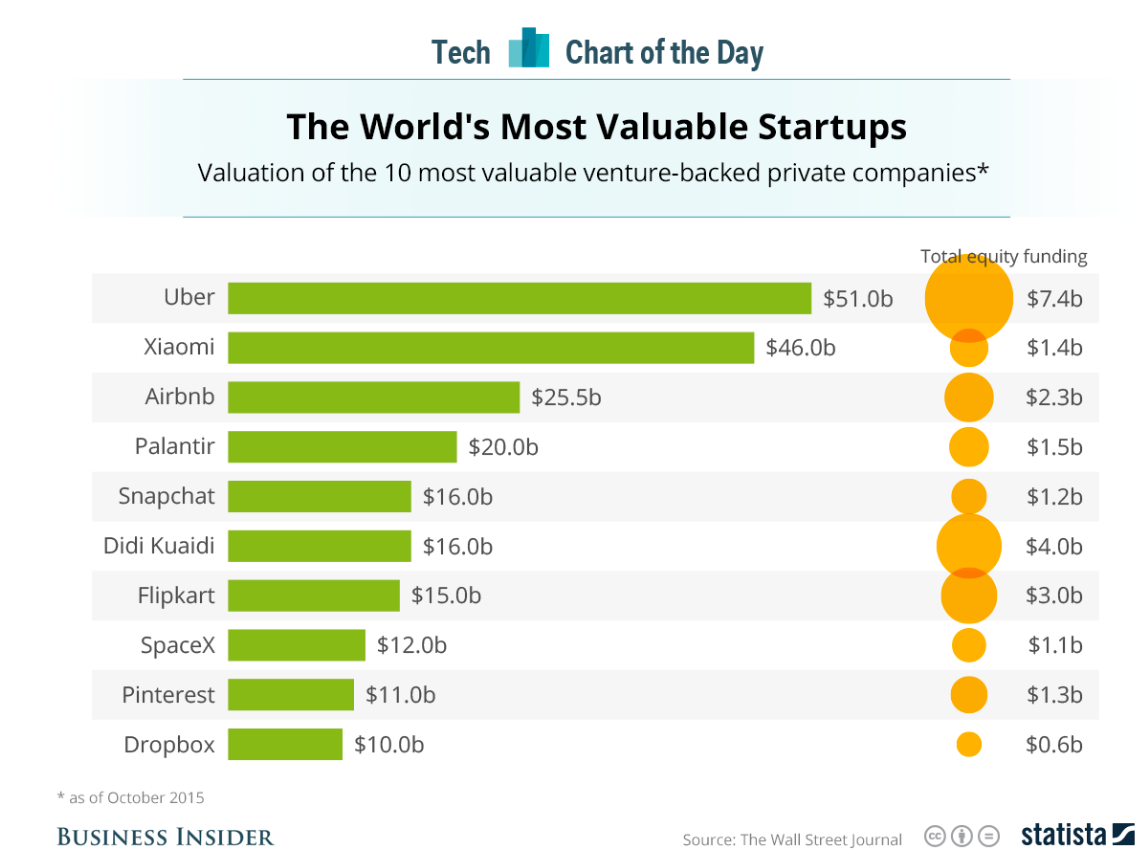
With its services now offered in more than 65 countries and over 450 cities worldwide, Uber has been undergoing one of the mobile app industry’s fastest global expansions. Only 3 years after launching their first non-US city in Paris in December 2011 (which took them only a month to prepare—more details below,) Uber was reaching a growth rate of launching a new city per day by the end of 2014.
Think about that for a second: all the data infrastructure, translations, UI changes, localized customer service involved—not to mention dealing with legal issues that sharing economy apps often run into.
Now imagine doing all of this for a new city on Day 1, then repeating it the next day. Then for the next 30 days without a break.
No matter how big your team or budget is, it’s a massive undertaking.
To put things into perspective, Uber is now a household name in 32 languages—and counting. They just completed 2 billion rides last week. The first billion rides took Uber 6 years—the second billion took only 6 months.
So how does Uber do it? How does this international company keep up with the rate of its own explosive growth and local needs?
In this post, we’ll share with you what Uber learned from their early localization success. We’ll go over how you should…
- strategically plan your localization by country and timeline
- ready your code for internationalization
- build tools and frameworks that help automate and optimize the translation and update processes
- prioritize high-quality translated and visual content that speak to your local market while staying true to your brand
But before we get there, let’s first talk about why Uber needs to expand globally as a business—and the importance of acing localization.
Localization in Uber’s virtuous growth cycle
Uber’s business model is simple: the app monetizes ride-sharing. Through their app, “Uber drivers” who have signed on to the program with their own private vehicles are connected with “riders,” who are end users looking for a lift.
The reasoning behind global expansion makes perfect sense. More markets equals more drivers and riders equals more business.
But the business logic behind doing localization well–beating out existing markets and other competitors, retaining satisfied customers, etc.—has a key additional layer for Uber: it improves their business.
Uber’s virtuous cycle. Geographic density is the new network effect. pic.twitter.com/NpmUnZgVfH
— David Sacks (@DavidSacks) June 7, 2014
Andrew Chen, Head of Supply Growth at Uber and tech industry influencer, analyzes the cycle of benefits to growing Uber locally on his blog using this diagram originally tweeted by David Sacks in 2014 and built upon by Bill Gurley.
As Chen explains, Uber as a “rocket-ship company of our generation” is primed for growth everywhere it expands to: “Each marketplace is 2-sided, with riders and drivers, has its own network effects driven by pickup times, coverage density, and utilization.”
So in other words, saturating the market and increasing geographic coverage results in these three categories, all of which makes Uber’s business run better. Now multiply this by more than 450 markets.
Chen says one of his biggest lessons about Uber has been the necessity of expanding globally:
“From a UX experience, Uber is “hit a button and a car comes,” but from a business standpoint, it’s a vast collection of hundreds of hyperlocal marketplaces in nearly 70 countries.” – Andrew Chen, Head of Supply Growth at Uber
By internationalizing the app to new markets—and doing it well, where each market reaches saturation—Uber can create exponential demand around the globe.
Exciting stuff, right?
Now let’s dive into the best practices from Uber’s global expansion:
1. Strategize which countries when as a first step
Former Head of Product at Uber, Mina Radhakrishnan, joined the company in the early days when it had only 20 employees. She helped spearhead Uber’s first international launch in Paris, back when Uber still existed as only a luxury black car service in two cities: San Francisco and New York.
As she outlines in her “Going Global” blog series, where she shares insights from the Uber localization process, it’s important to decide on a structured plan on which countries to hit, and when, before you do anything else.
“You don’t turn on every corner of the world overnight. Rather, you work your way through different geographies in some priority order.” – Mina Radhakrishnan, Former Head of Product at Uber
To do this, she suggests designing a rubric to categorize countries into the following:
- tier 1: as soon as possible
- tier 2: within the next 6 months
- tier 3: everything else
Based on the company’s goals and user base, as well as industry, this rubric will take into account different factors for a product’s potential growth in new markets.
Mina suggests understanding some baseline facts about your target markets like population, literacy rate, and internet penetration. At a more in-depth level, investigate device usage, connectivity, intended users, pricing, and other barriers to entry.
2. Prepare your code for internationalization
In a presentation at #ProductSF, Mina recalls how the team decided to launch Paris. CEO Travis Kalanick was scheduled to give a keynote presentation at LeWeb, the annual European tech conference, in December 2011. When he casually mentioned that it would be great to launch Uber Paris at the conference, Mina and the rest of their team got right on board and started planning.
They were set to launch in 30 days. With no prior international launch experience. Yikes.
It was a complete scramble for the team, especially on their technical end. None of their systems were prepared for going abroad.
Here are some of the technical challenges you run into when localizing:
Rushing translations
How much content you need to translate depends on the number of markets you want to hit and how deep you want to go. Even in Uber’s case, where they needed to go all the way in only one market, there’s still a ton of content to localize.
Aside from the text in the app itself, there’s also your app store listing, user manuals, and website content. And don’t forget about your marketing materials and social media content.
Our research shows that professional translators can translate up to 2,000 words per day, but what people often forget to factor in is that the highest-quality translation needs good back-and-forth between translator and product managers on clarifying certain parts of the source text or any on-the-go changes—and that takes time.
Foreign payment systems
While still setting up for localization, the Uber team realized they couldn’t get a merchant account in Paris in 30 days for payments. So they planned to charge riders in US dollars early on. They thought about giving users a discount because there would be foreign transaction fees—but wait, the discount will have to be converted into dollars too since they didn’t have euro credit yet.
As you can see, it gets pretty messy when dealing with money in a foreign country.
Mina’s advice on handling international payments is to design a roadmap by asking the following questions:
- Does your primary payment method fit the market(s) you’re going into?
If your app uses credit card payments but credit card penetration is low in this new market, how does that affect your localization plan? - What are the regulations with online transactions?
What kind of information do you need to collect for each transaction? - What do you need in terms of merchant accounts, bank accounts, and offices?
Pay attention to the timeline needed to set these up and whether you need a physical office space. - If you can’t get to it now, can you take care of it later?
Is it possible to launch with only credit cards to start (relatively easier process) and build on this later?
Of course, as with any localization project, prioritize local standards first.
Case in point: Uber completely rehauled their payment system in India to accept cash after realizing how different the payment landscape was. Now, what started as a unique case study in India has become common practice for Uber across multiple markets.
Prepping content for international formats
Different regions have different ways of formatting content.
For example, in Hong Kong, addresses are written with the apartment number first, followed by the building street address, whereas the order is reversed in the US.
In localization, merely translating content is not enough—you need to format everything to the local standard, such as symbols for currencies, telephone numbers, postal codes, etc.
Uber spends a lot of time researching international standards and applying them to their app. From Mina’s experience, she suggests proactively updating standardized sources of information and metrics in internal references. Even if these are not integrated right away into the UI, having the information ready will result in cleaner data in your systems later.
One way to jumpstart formatting your content to be international-friendly is to refer to Unicode’s Common Locale Data Repository (CLDR), the world’s largest library of standard locale data. Trust us — using this database will save you so much more time than Googling “phone number format [country name]” 450+ times.
Building a sustainable system for localization
In the end, the Uber team hit their target date and launched Paris at the LeWeb Conference in December 2011.
…But then they spent the next 6 months completely revamping the whole system: “rewriting, refactoring, rebuilding, redesigning” their original launch.
Given the time limit they had, “there was no way we could have launched Paris while building a robust, maintanable system,” admits Mina.
Read tips from Cisco’s Head of Internationalization on building a robust system of localization.
Create a translation workflow that is consistent with your brand.
For the long term, It’s just as important to ensure that all your communication from the time you launch stays consistent with the voice of your brand while adapting the tone of the local culture.
Mina suggests building a workflow in which your translation not only stays true to the brand, but also plays well to the intended market. To do this, you’ll need to articulate a “core marketing message” that has the final say over your linguistic and cultural translations.
The key takeaway here is that, to expand, you need scalable, well-built systems, with strong, tested tools so you can stay ahead of your technical localization process.
3. Build tools to efficiently communicate system-wide changes
One of the key values at Uber is “designing for flexibility.” As Mina explains, this means not only rolling with the punches, but also building systems and tools that let different team members communicate and integrate changes efficiently and effectively, across all their localized versions.
Their goal in doing so is to make their product as local as possible, while maintaining the “high-level awesomeness” of the Uber brand, as Mina puts it.
When Uber was just warming up with their first few international cities, they tried to do the same thing for every city and added updates to new cities manually.
They quickly outgrew this.
“We were fine when we were doing cities at a rate of one a month, instead of 5-7 every week,” explains Mina. It just didn’t make sense for all their 450+ markets to be identical.
“Designing for flexibility” meant they had to seriously rethink how technology and operations intersect, and build products that would encourage creativity in adapting the app to the local market and being able to offer services unique to each city.
“Growth requires flexibility, and growth should also spur innovation.” – Mina
The result was making their engineering as self-service as possible, so local teams could “wake up one morning” and change the features of their localized app easily to whatever their local customers needed or wanted, like offering different car types for every city.
It also means being able to coordinate global marketing campaigns events easily, like hosting Uber On-Demand Ice Cream in 400 cities on one day this summer.
Here’s the scoop on the campaign in 2014, covering 144 cities:
In recent years, Uber has increased their efforts to document the unique localization behind these international events.
Here’s what Uber Ice Cream looked like in Puerto Rico this year:
…And here’s Australia, featuring ice cream created by well-known Aussie chefs:

4. Adapt to local needs
The key to going global is focusing on the local market as the most important unit.
As Uber CEO Travis Kalanick explains, “being local and speaking with local voice is important when you’re doing transportation and means you know what’s going on for the city.”
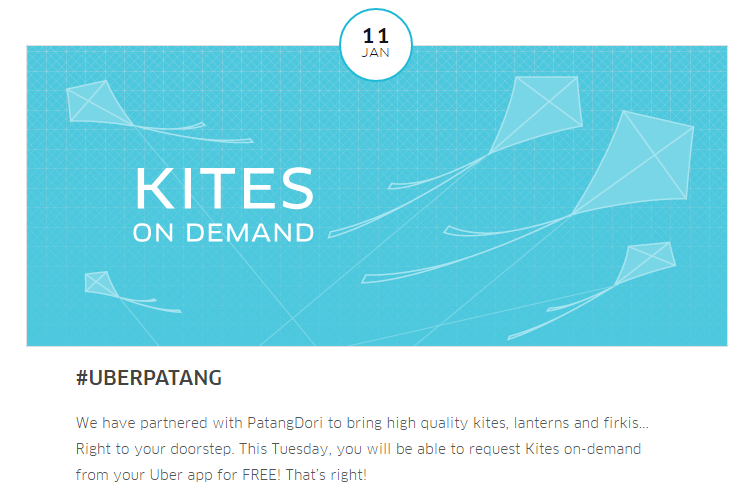
One of Uber’s localized marketing campaigns in India featured on-demand kites for Makar Sankranti, a Hindu festival that uses them.
Everything with Uber is based locally: from the driver to the rider to their destinations. The app needs to reflect over 450 cities’ unique language and cultural needs. As a result, Uber’s localization efforts go beyond the basics, to adapting their app to dialects within a city, culture, habits, and unique needs of their international consumer-base.
And Uber knows this better than anyone. That’s why they’re allegedly investing USD $1.15B in their global expansion and operations, among other goals.
Why spend so many resources on building at the local level? Because details matter. And consumers buy into products that feel familiar to them.
Here are a few highlights of how Uber successfully puts the “local” in localization:
Language is cultural.
High-quality translations ensure that cultural context is taken into account.
When the Uber team first launched in London, they spent a long time trying to find a right word to replace “people carriers” or “big cars” (the local term for SUVs) because these were both too long to fit on their UI. One idea on the drawing board had just the words “BIG BLACK” on their homepage. Luckily, that idea quickly got shut down.
In the end, they decided on “UberXL,” a fun play on the original UberX option.
Visual cohesion matters.
Visuals are just as important as words when it comes to speaking the local language.
When you open any version of Uber around the world (and a Toronto designer actually tried this), there’s subtle UI changes that show careful localization considerations—but there’s enough visual consistency so that you know you’re still using Uber, no matter where you are.
The same principle applies to Uber’s complete two-year design overhaul early 2016, in which the company meticulously redesigned their company logo and app icon, and introduced specific color palettes and mood boards for individual markets to “celebrate cities.” While the redesign faced backlash online, top brand strategist Andy Raskin has notably declared the new app icon as “genius.”
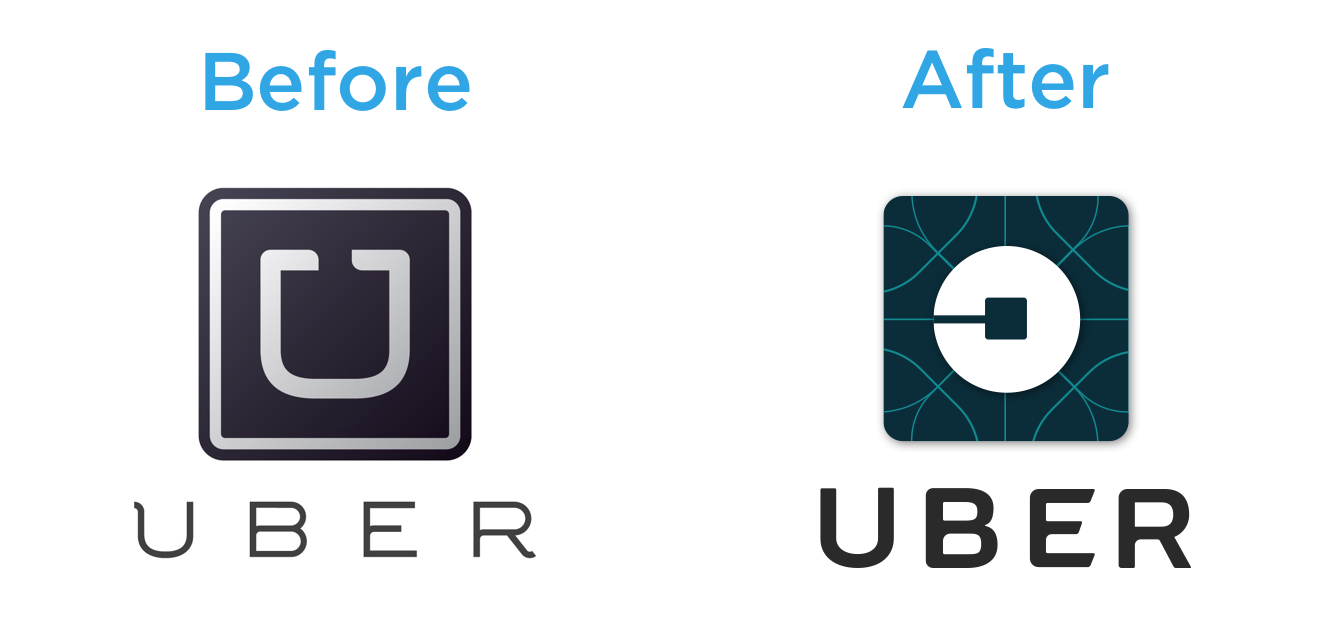
According to Jessi Hempel’s story on this “radical rebranding” on WIRED.com, Uber has launched visual localization in each of their 65 countries at time of launch, with each country receiving a “toolbox” of customized colors and patterns, illustrations, and guidelines for photos for their own markets. To tie everything together, they’ve also chosen five “global colors” for Uber’s international design.
They’ve released the mood boards for four cities at the time of launch, but hope to add “hundreds more” over time.
“Every city has its own character and our long term goal is to have unique designs for cities as well as countries.” – Travis Kalanick, CEO and co-founder at Uber

 As these local markets rely on these visual guidelines for expansion, they’ll have more autonomy while keeping with the global Uber brand.
As these local markets rely on these visual guidelines for expansion, they’ll have more autonomy while keeping with the global Uber brand.
Build trust at the local level
Whether you’re a car-hire app like Uber or a mobile games developer, you’re always promising the end-user something with your product. There’s a degree of trust in every good app-based interaction, whether it’s a fun, challenging game level suitable to the target audience or an efficient, safe ride to your destination.
Uber takes this trust very seriously, especially in the safety regulations and requirements that are specific to transportation in each city.
To prepare for their Paris launch, every one of Uber’s 20 employees at the time studied Paris’ traffic, density, and transportation laws from top to bottom.
Most recently, in the U.S. alone, Uber has pushed new features encouraging safer driving while using their app based on road safety data. In the past, they’ve been known to strengthen privacy protections on clients’ data and customer service for rider safety. Responding quickly to user needs can turn PR nightmares into significant improvements to the app and its services.
Looking ahead
As Uber continues to expand at an aggressive pace, some argue that their rate of growth is not sustainable—or worse, criminal. As Fortune.com points out, Uber’s expansion model often involves entering a territory before legal and regulatory redtape is cleared up. This classifies them as an “illegal taxi service,” and leaves Uber and Uber drivers open to lawsuits and court cases around the world. Another major criticism is that in doing so, they’re not respecting the diverse political, economic, and cultural contexts of their new markets.
It’ll be interesting to see what Uber will look like in another 6 months. Will they reach 3 billion rides? Or will they be stalled by the growing concerns over their rapid growth?
Wrap up
Of course, we know not everyone has USD $1 billion lying around for their localization budget. But these lessons from Uber’s global expansion success are a good checklist for any localization project:
- strategically plan your localization by country and timeline
- ready your code for internationalization
- build tools and frameworks that help automate and optimize the translation and update processes
- prioritize high-quality translated and visual content that speak to your local market while staying true to your brand
Interested in how other big companies are doing localization? Read our insights on Airbnb, Spotify, and GoDaddy to learn more.
If you want to grow as successfully globally as Uber, get a head start by figuring out your Minimum Viable Localization (MVL):
And when you’re ready to localize your app, read our free step-by-step Essential Guide to App Localization. Good luck!

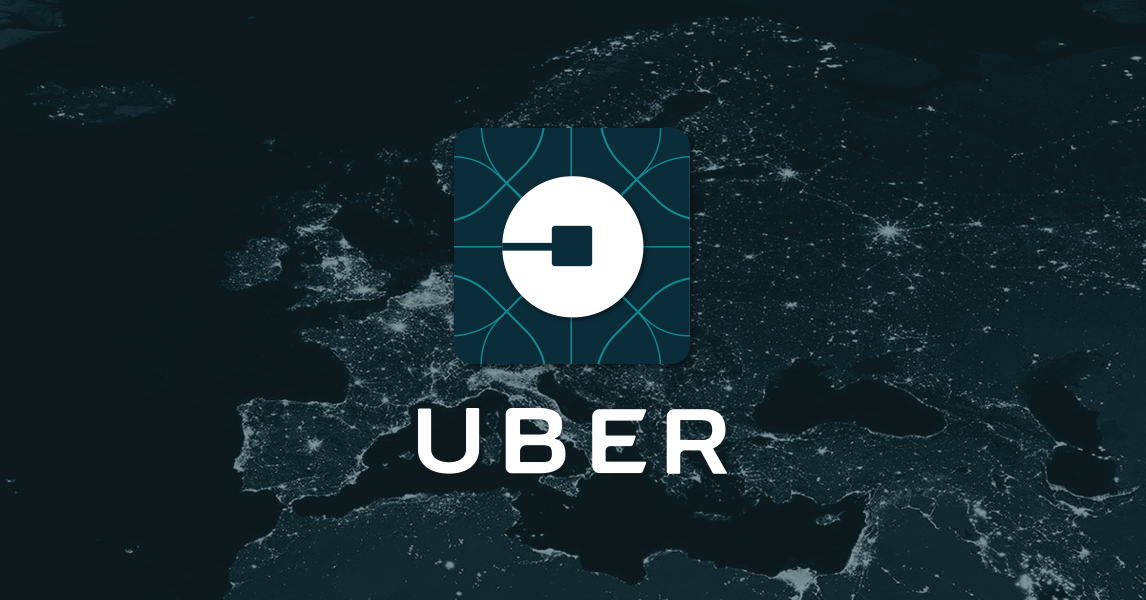
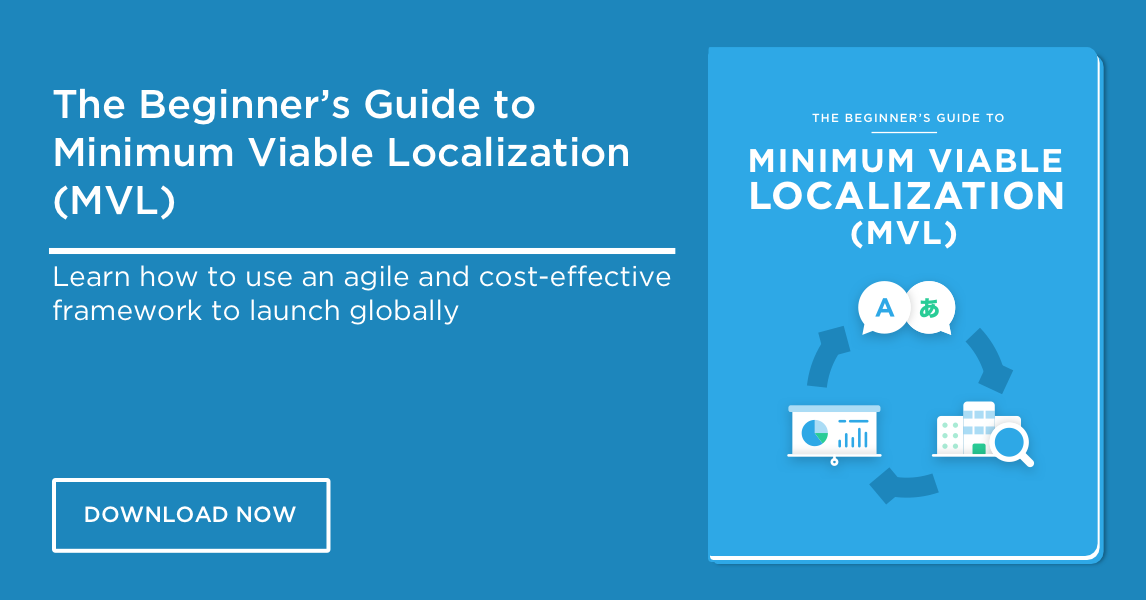

 Written by -
Written by - 

 Written by
Written by 



Great overview of how REAL localization should like in the 21st century! Thanks!
Thanks for reading, ContentQuo!
If you can’t get to it now, can you take care of it later?
I agree with you.
Taking the plunge to create an app!! This article pretty much sums up the process…follow your intuition…build as you go…being responsive with your respective market. Thank you!
Yes, we completely agree! And making sure to spend time and effort on good localization is key. Thanks for reading!
This makes it sound like One Sky translates Uber’s apps? I don’t believe that to be the case.
Hi pjsa85a,
Thanks for your comment! We hope we weren’t misleading—we simply thought that Uber showed great results in their global expansion and wanted to share some insights on their strategy with our readers. We OK’d the article with a few people we quoted from Uber who thought it was a fair analysis of their plan.
But if you’re secretly Travis Kalanick looking for a new localization company…you know where to reach us 😉
https://uploads.disquscdn.com/images/2adfd63560cef564da0bb289c3403abe9e847e8e4818ec4053b3963703bafa61.png
Awesome article!
I do think that something you’re missing is Uber’s growth through their referral program! That’s what really gave them the initial variety of users -> drivers -> locations.
Check this out 🙂
https://www.sweettoothrewards.com/blog/how-ubers-referral-program-drives-radical-growth/
Thanks for reading, ContentQuo!
According to Jessi Hempel’s story on this “radical rebranding” on WIRED.com, Uber has launched visual localization in each of their 65 countries at time of launch, with each country receiving a “toolbox” of customized colors and patterns, illustrations, and guidelines for photos for their own markets. To tie everything together, they’ve also chosen five “global colors” for Uber’s international design.
Uber is on a roll. In India, Uber is going on a new heights. That driver profile option is very good.
Uber is always my favourite on the go service be it for shopping, food, cabs, etc. My other favourite online portal is the Kroger Stores, you can shop there and enjoy 50 dollar worth shopping rewards for the next time shopping.
Check https://www.krogerfeedback.red/ for more details.